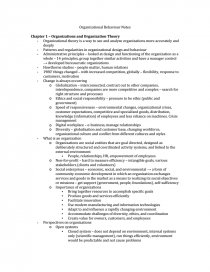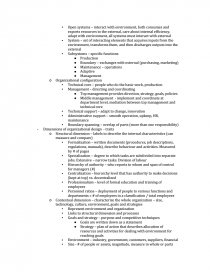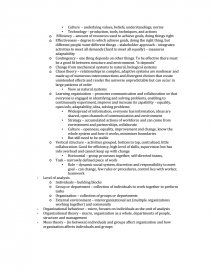Organizational Behaviour Notes
Essay by greu3130 • May 24, 2015 • Study Guide • 1,495 Words (6 Pages) • 1,521 Views
Page 1 of 6
Organizational Behaviour Notes
Chapter 1 – Organizations and Organization Theory
- Organizational theory is a way to see and analyze organizations more accurately and deeply
- Patterns and regularities in organizational design and behaviour
- Administrative principles – looked at design and functioning of the organization as a whole – 14 principles, group together similar activities and have a manager control → developed bureaucratic organizations
- Hawthorne studies – people matter, human relations
- 1980’ things changed – with increased competition, globally – flexibility, response to customers, motivation
- Change is always occurring
- Globalization – interconnected, contract out to other companies, interdependence, companies are more competitive and complex – search for right structure and processes
- Ethics and social responsibility – pressure to be ethic (public and government)
- Speed of responsiveness – environmental changes, organizational crises, customer expectations, competitive and specialized goods, distribution, knowledge (information) of employees and less reliance on machines. Crisis management
- Digital workplace – e-business, manage relationships
- Diversity – globalization and customer base, changing workforce, organizational culture and conflict from different cultures and styles
- What is an organization
- Organizations are social entities that are goal directed, designed as deliberately structured and coordinated activity systems, and linked to the external environment
- People, relationships, HR, empowerment of employees
- Non-for-profit – hard to measure efficiency – intangible goals, various stakeholders (clients and volunteers)
- Social enterprises – economic, social, and environmental → a form of community economic development in which an organization exchanges services and goods in the market as a means to realizing its social objectives or missions – get support (government, people, foundations), self-sufficiency
- Importance of organizations
- Bring together resources to accomplish specific goals
- Produce goods and services efficiently
- Facilitate innovation
- Use modern manufacturing and information technologies
- Adapt to and influence a rapidly changing environment
- Accommodate challenges of diversity, ethics, and coordination
- Create value for owners, customers, and employees
- Perspectives on organizations
- Open systems
- Closed system – does not depend on environment, internal systems only (scientific management), run things efficiently, environment would be predictable and not cause problems
- Open systems – interact with environment, both consumes and exports resources to the external, care about internal efficiency, adapt with environment, all systems must interact with external
- System – set of interacting elements that acquires inputs from the environment, transforms them, and then discharges outputs into the external
- Subsystems – specific functions
- Production
- Boundary – exchanges with external (purchasing, marketing)
- Maintenance – operations
- Adaptive
- Management
- Organizational configuration
- Technical core – people who do the basic work, production
- Management – directing and coordinating
- Top management provides direction, strategy, goals, policies
- Middle management - implement and coordinate at department level, mediation between top management and technical core
- Technical support – adapt to change, innovation
- Administrative support – smooth operation, upkeep, HR, maintenance
- Boundary spanning – overlap of parts (more than one responsibility)
- Dimensions of organizational design - traits
- Structural dimension – labels to describe the internal characteristics (can measure and compare)
- Formalization – written documents (procedures, job descriptions, regulations, manuals), describe behaviour and activities. Measured by # of pages
- Specialization – degree to which tasks are subdivided into separate jobs. Extensive – narrow tasks. Division of labour
- Hierarchy of authority – who reports to whom and span of control for managers (#)
- Centralization – hierarchy level that has authority to make decisions (kept at top) vs. decentralized
- Professionalism – level of formal education and training of employees
- Personnel ratios – deployment of people to various functions and departments = # of employees in a classification / total employees
- Contextual dimension – characterize the whole organization – size, technology, culture, environment, goals and strategies
- Represent environment and organization
- Links to structural dimension and processes
- Goals and strategy – purpose and competitive techniques
- Goals are written down as a statement
- Strategy – plan of action that describes allocation of resources and activities for dealing with environment for reaching goals
- Environment – industry, government, customers, suppliers, financial
- Size - # of people or assets, magnitude, measure in whole or parts
- Culture - underlying values, beliefs, understandings, norms
- Technology – production, tools, techniques, and actions
- Efficiency – amount of resources used to achieve goals, doing things right
- Effectiveness – degree to which achieve goals, doing the right thing, but different people want different things – stakeholder approach – integrates activities to meet all demands (hard to meet all equally) – measures adaptability
- Contingency – one thing depends on other things. To be effective there must be a good fit between structure and environment. “it depends”
- Change from mechanical systems to natural, biological systems
- Chaos theory – relationships in complex, adaptive systems are nonlinear and made up of numerous interconnections and divergent choices that create unintended effects and render the universe unpredictable but can occur in large patterns of order
- View as natural systems
- Learning organization – promotes communication and collaboration so that everyone is engaged in identifying and solving problems, enabling to continuously experiment, improve and increase its capability – equality, open info, adaptability, idea, solving problems
- Widespread of information, everyone has information, ideas are shared, open channels of communication and environment
- Strategy – accumulated actions of workforce and can come from environment and partnerships, collaborate
- Culture – openness, equality, improvement and change, know the whole system and how it works, minimizes boundaries
- But still need to be stable
- Vertical structure – activities grouped, bottom to top, centralized, little collaboration. Good for efficiency, high level of skills, supervision but has info overload and cannot keep up with change
- Horizontal – group processes together, self-directed teams,
- Task – narrowly defined piece of work
- Role – dynamic social system, discretion and responsibility to meet goal – can change, few rules or procedures, control lies with worker, teamwork
- Level of analysis
- Individuals – building blocks
- Group or department – collection of individuals to work together to preform tasks
- Organization – collection of groups or departments
- External environment – interorganizational set (multiple organizations working together) and community
- Organizational behaviour – micro, focuses on individuals as the unit of analysis
- Organizational theory – macro, organization as a whole, departments of people, structure and management
- Meso theory – (in between) individuals and groups affect organization and how organization affects individuals and groups
...
...
Only available on ReviewEssays.com


